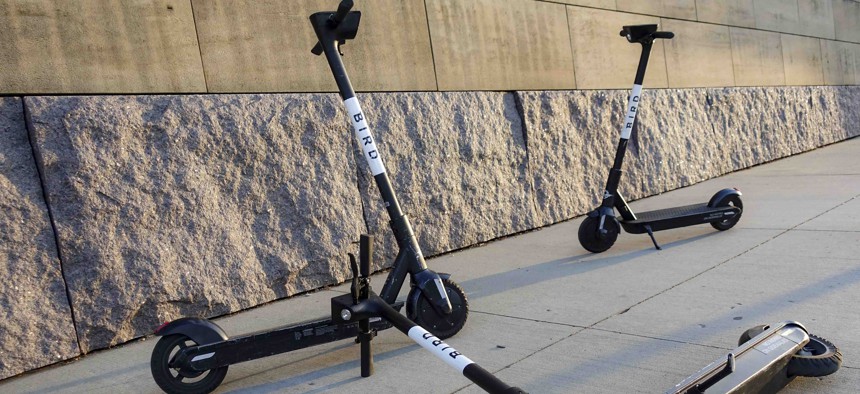Signs of Big Growth in Shared Bike and Scooter Trips Before Virus Hit

Sharable electric scooters by Bird Rides, Inc. wait on downtown sidewalks for pedestrian use, Wednesday, Oct. 2, 2019, in downtown Cincinnati. AP Photo/John Minchillo

Connecting state and local government leaders
A new report shows that the number of trips on these “micro-mobility” vehicles was up 60% last year over 2018.
Americans took 136 million trips on shared bicycles and electric scooters last year, a 60% increase over 2018, according to a new report. The figures underscore the rise in popularity of the vehicles in cities across the U.S., but also reflect a time before daily life and travel routines were upended by the coronavirus pandemic.
For the past four years, the National Association of City Transportation Officials has compiled statistics on “shared micro-mobility” use—a category that covers shared bikes, including dock-less electric bicycles, and electric scooters. Scooters made up a big portion of overall trips last year—86 million, or 63%, of the total 136 million.
Station-based traditional and electric bicycle travel made up 40 million of the trips and dock-less electric bikes clocked in at 10 million.
Total shared micro-mobility trips totaled 84 million in 2018 and 35 million in 2017, according to figures in the report. In 2018, scooter trips totaled just 38.5 million.
The report attributes some of the strong increase in scooter trips to shared scooter services expanding to more cities. But it also notes that this growth into new markets by scooter companies was sometimes unstable, with firms exiting certain places even before the virus hit.
Now, questions hang over what the future holds for shared bikes and scooters as the pandemic continues and once it subsides.
Household trips and transit ridership plummeted in late March and early April as the virus took hold, the report notes.
Millions of Americans are out of work and droves of workers with office jobs in cities have been working from home. Many businesses, like bars, venues and restaurants—the kinds of places that people might have once zipped to on a scooter after work—are either closed or offering curtailed service as the nation battles to keep the virus from flaring up or spreading.
Trips taken on the nation’s eight largest station-based bike share systems decreased by an average of 44% from March to May, the report says. That’s a sharp decline, but less than the overall estimated drop in household trips in those cities during that time.
The NACTO report points out that shared bikes and scooters could provide alternatives to cars for people who may be wary of crowding onto buses or subways, or as transit service is cut due to revenue shortfalls that the pandemic is causing.
There are signs that bike ridership and sales have been up during the course of the virus outbreak. But in cities with harsher winters, bicycling can lose its appeal as the colder months roll around.
While scooters were booming in popularity before the pandemic hit, there were challenges with them as well. Even last year and early this year, before the virus spread, scooter companies, like Lime and Bird, struggled to turn profits. And as they tried to expand, the companies also sparred at times with local governments over regulations.
Scooters have also raised safety concerns. There were at least 18 shared scooter-related fatalities last year, according to the report. And when haphazardly parked, or left strewn on sidewalks, scooters can pose a public nuisance, as well as serious obstacles for people with disabilities—an issue that disability rights advocates have sued over.
Still, proponents of bike and scooter sharing say micro-mobility provides a useful addition to the transportation options that are available in traffic-congested cities, giving people an alternative to driving their personal vehicles, or turning to Lyft or Uber for a ride.
Shared bike and scooter trips tend to be short, the NACTO report says, typically averaging in the 11 to 12 minute range, or one to one-and-a-half miles in distance. Survey data, the report adds, indicates that people are replacing car trips by taking shared bikes or scooters instead, but there is currently no industry wide report on how significant this shift is.
Activity with the vehicles is heavily concentrated in a handful of major cities.
Last year, 87% of docked bike-share trips took place in the top six ridership cities or regions, including places like the San Francisco Bay Area, Boston and New York City. It’s a similar story with scooters, but to a lesser degree, with 38% of all rides in the six biggest ridership cities, which are Atlanta, Georgia, Austin and Dallas, Texas, Los Angeles and San Diego, California and Washington, D.C.
The report notes that smaller bike-share systems didn’t see the same gains as large systems last year and that while bike-share trips increased overall, ridership actually declined in three-quarters of the systems, with growth driven by the largest ones.
A copy of the NACTO report can be found here.
Bill Lucia is a senior reporter for Route Fifty and is based in Olympia, Washington.

NEXT STORY: When high-quality supplier data becomes mission critical





